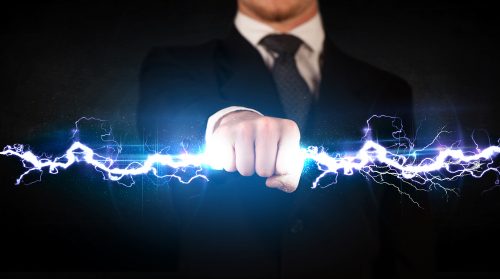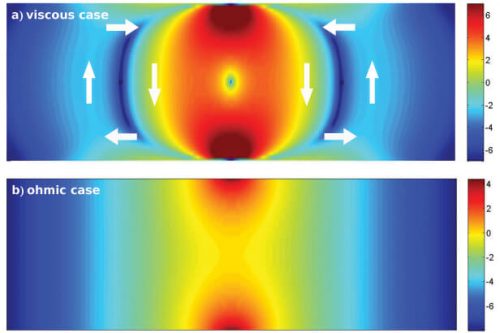A new study examines the question of whether electricity is a stream of electrons or a type of liquid

Physics textbooks have always described electricity as a stream of electrons. When this current passes through a conductive material, such as a copper wire, the electrons collide with the atoms of the material - and this causes a resistance that slows down the flow. Furthermore, according to Ohm's law, electric current in a conductive material will always flow from high to low voltage. On the other hand, if the electron stream behaved like a liquid stream, most of the collisions would occur not between the electrons and other particles but between the electrons themselves - as happens in water and other liquids, where the molecules of the liquid collide with each other. If it were possible to prove that electrons are capable of behaving like liquids, this proof would open a completely new direction in the study of the properties of the electric current and changing these properties.
Is an electric current able to adapt itself to liquid properties? The answer to this question may lead to the writing of a new chapter in basic physics textbooks. In a new study, recently published in the scientific journal Nature physics, his age Prof. Grigory Falkowitz from the Weizmann Institute of Science and Prof. Leonid Levitov from the Massachusetts Institute of Technology that, surprisingly, the current can, in some cases, flow in reverse - from low to high voltage.

Prof. Falkowitz, an expert in hydrodynamics in the Department of Physics of Complex Systems, suggested conducting a classic test on the subject. If an electric current behaves like a liquid, then it should create eddies under certain conditions - as all liquids do. In these eddies, the current rotates around an axis, so that part of the liquid flows in the opposite direction from which the flow started. These eddies are created because the liquid particles react with each other. When they are pushed in a certain direction, the particles transfer part of the momentum to their neighbors, thereby diverting the movement of the other particles to the side and causing them to rotate around themselves. These are the eddies that allow, for example, fish to swim: the fish twist their bodies in undulating movements, which create eddies to their sides, which push them forward.
Prof. Flakovitz and Prof. Levitov developed a theoretical model that showed that an electric current does indeed produce eddies. The scientists made calculations describing the flow of electrons in a very simple system - a narrow, two-dimensional surface made up of carbon atoms, called "graphene". These calculations showed that when the electric current - moving in an electric field between minus and plus, or from high to low voltage - reaches the edge of the surface, the electrons turn to the side and then back, so that they flow in the opposite direction - like in eddies in water - from plus to minus.
This discovery points to the possibility of completely new angles in the study of electric currents, which may and sometimes intersect in the field of fluid dynamics. In addition, since particles in a liquid affect each other from a distance, these studies may lead, in the future, to new ways to remotely control electric currents in electronic devices.

The findings of this theoretical study were recently confirmed in an experiment carried out in Great Britain by scientists who won the 2010 Nobel Prize in Physics for the discovery of graphene. In an independent study that was not related to Prof. Flakovitz's work, these scientists built a device similar to the theoretical device described in the article by Prof. Flakovitz and Prof. Levitov. As reported in the scientific journal Science, the scientists were able to experimentally observe an electric current that behaved like a liquid current and created eddies.

4 תגובות
I was quite disappointed in the article about physics already at the beginning of the article to read 2 incorrect facts:
"When this current passes through a conductive material, such as a copper wire, the electrons collide with the atoms of the material - and this causes a resistance that slows down the flow. Beyond that, according to Ohm's law, electric current in a conductive material will always flow from high to low voltage." For almost a century we have known that resistance does not arise from the collision of the electrons in the atoms of matter, this model called the "Droud model" fell quite quickly after it was proposed. Also, Ohm's law links current, resistance and voltage, what determines the direction of current flow is simply the definition of voltage and current, regardless of resistance and Ohm's law.
The aspect described here is different. It describes the formation of vortices from interaction with the sides of the waveguide and not from movement as a plasma and not from movement as an electron liquid in the fermi liquid sense.
Electricity is a wave that consists of electrons that are a wave function in itself, and are harmonically coordinated with the electric wave.
Therefore it collects both particles and wave. Electricity in lightning is charged particles moving at the speed of light. It is a plasma, a fourth state of aggregation, and can be analyzed like an electron fluid. It is clear that vortices will be created given the conditions of what the Academy of Linguistics calls turbulence, and what physicists call a phase transition, and there are some of the best theories in the world for this.
What characterizes this liquid is only obstacles?